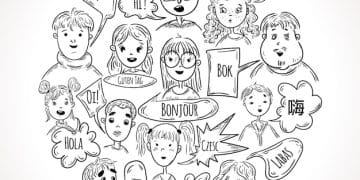Milgram’s Obedience Experiments: 2025 US Society Insights

Milgram’s obedience experiments offer critical insights into human behavior under authoritative pressure, lessons particularly pertinent for understanding societal dynamics and individual responses within the evolving complexities of 2025 US society, emphasizing the enduring challenge of balancing compliance with moral autonomy.
The famed experiments conducted by Stanley Milgram in the 1960s continue to resonate with profound implications for understanding human behavior. When we delve into Exploring the Psychology of Obedience: Lessons from Milgram’s Experiments in the Context of 2025 US Society, we confront uncomfortable truths about conformity, authority, and our own moral compass. How do these insights from half a century ago illuminate the intricate social fabric of modern America?
Milgram’s Groundbreaking Research: A Historical Overview
Stanley Milgram’s studies on obedience to authority represent one of the most controversial yet influential series of experiments in social psychology. Conducted in the aftermath of World War II, his primary motivation was to understand how seemingly normal individuals could participate in atrocities, particularly in the context of Nazi Germany. He hypothesized that the key lay in the power of authority figures to command compliance, even when it conflicted with personal conscience.
The core setup involved three roles: the “experimenter,” the “teacher” (the participant), and the “learner” (a confederate). Participants were told they were part of a study on memory and learning, where the teacher would administer electric shocks to the learner for incorrect answers. Crucially, the shocks were fake, and the learner’s reactions (screams, protests, eventual silence) were pre-recorded. The real experiment was observing how far participants would go when instructed by the experimenter to continue, despite the learner’s apparent suffering.
The Shocking Results and Ethical Dilemmas
Milgram’s findings were, for many, deeply unsettling. A significant majority of participants complied with the experimenter’s demands, administering what they believed were increasingly severe shocks, up to the maximum 450 volts, labeled “XXX.” This high level of obedience challenged prevailing notions of individual autonomy and confirmed the powerful influence of situational factors over dispositional traits. It suggested that many people are willing to obey an authority figure, even if it harms another person, highlighting the profound ethical questions surrounding such research.
- Deception was central to the experiment’s design, as participants believed the shocks were real.
- Emotional distress was evident in many participants, torn between the experimenter’s commands and their own moral qualms.
- The long-term psychological impact on participants became a major point of debate regarding research ethics.
- Milgram emphasized the importance of debriefing, but concerns about potential harm persisted.
Despite the ethical controversies, Milgram’s experiments remain a cornerstone of social psychological literature. They illuminated the often-unseen forces that shape human behavior, forcing us to confront the uncomfortable truth that under certain conditions, ordinary individuals can be swayed to act against their own moral inclinations.
Understanding the Mechanics of Obedience: Key Factors
Milgram’s experiments weren’t just about showing that people obey; they meticulously explored the conditions that amplified or diminished obedience. Several factors consistently emerged as critical in influencing a participant’s willingness to comply with the experimenter’s instructions, even when those instructions conflicted with their sense of right and wrong.
One primary factor was the perceived legitimacy of the authority figure. Milgram found that when the experimenter was present in the room and dressed in a lab coat, symbolizing scientific authority, obedience levels were significantly higher. Conversely, when the experimenter delivered commands by phone, or when the experiment was moved from Yale University to a less prestigious location, obedience dropped. This underscores the power of symbols and context in legitimizing authority.
The Role of Proximity and Responsibility
The physical proximity between the teacher and the learner, and between the teacher and the experimenter, also proved crucial. When the learner was in the same room as the teacher, requiring direct observation of their distress, obedience decreased. When the teacher had to physically force the learner’s hand onto a “shock plate,” obedience plummeted further. This suggests that the psychological distance to the victim plays a significant role in one’s willingness to inflict harm.
Furthermore, the diffusion of responsibility was a salient theme. Participants often justified their actions by deferring responsibility to the experimenter, stating they were “just following orders.” This cognitive mechanism allowed them to distance themselves from the consequences of their actions, perceiving themselves as agents carrying out another’s will rather than autonomous individuals making moral choices.
- Legitimacy of Authority: Higher obedience when authority is perceived as legitimate and physically present.
- Proximity of Victim: Decreased obedience as the teacher’s physical and emotional proximity to the “victim” increased.
- Proximity of Authority: Decreased obedience when the authority figure was not physically present or commands were indirect.
- Diffusion of Responsibility: Participants shifted moral responsibility to the authority figure, reducing their own feelings of guilt.
These factors provide a powerful conceptual framework for understanding how situational pressures can profoundly influence individual behavior, often to an extent that defies common assumptions about free will and moral agency. The elegance of Milgram’s design lay in systematically manipulating these variables to reveal their precise impact.

Milgram’s Echoes in 2025 US Society: Contemporary Relevance
While conducted over half a century ago, the lessons from Milgram’s experiments remain disturbingly relevant in 2025 US society. The fundamental power dynamics between authority and the individual, the pressures of conformity, and the mechanisms of rationalization are far from obsolete; they manifest in new and complex forms within our modern landscape. Understanding these echoes is crucial for navigating contemporary social challenges.
Consider the ever-present influence of digital platforms and how they shape public discourse. Online, the “experimenter” authority figure can be a charismatic leader, a viral influencer, or even the algorithm itself, subtly nudging behavior and opinion. Individuals may find themselves amplifying information or joining online movements, driven by a perceived social hierarchy or the “logic” of the platform, sometimes without fully scrutinizing the broader ethical implications of their actions.
The Digital Age and New Forms of Obedience
In 2025, the concept of obedience extends beyond a single person in a lab coat. We see its manifestations in mass adherence to certain media narratives, the rapid spread of misinformation, and the polarization of political views. The diffusion of responsibility, so eloquently demonstrated by Milgram, is amplified in digital spaces, where anonymity and distance from “the victim” (the other side of an argument, for instance) can lead to more extreme behaviors than might occur face-to-face.
- Social Media Algorithms: Act as subtle authority figures, shaping information consumption and potentially reinforcing echo chambers.
- Online Groupthink: The pressure to conform within digital communities can lead to rapid adoption of views, sometimes without critical evaluation.
- Political Polarization: Adherence to party lines and rejection of opposing viewpoints, even when conflicting with individual values, akin to obedience to a group authority.
- Misinformation Spread: Individuals sharing information without fact-checking, deferring to the perceived authority of the source or the crowd.
The challenges of ethical behavior in the digital age often involve subtle forms of coercion and a complex interplay of personal belief with collective pressure. Milgram’s work provides a lens through which to examine these phenomena, urging us to question the sources of our information and the motivations behind our compliance.
Navigating Authority: Group Identity and Conformity
Beyond the direct commands of an individual authority figure, Milgram’s work implicitly touches upon the broader societal pressures of group identity and conformity. In 2025 US society, these elements are particularly potent, influencing everything from consumer choices to political affiliations. The desire to belong, to be perceived as “one of us,” can be a subtle yet powerful driver of obedience, often to unwritten social rules or group norms.
Humans are inherently social creatures, and our identities are often intertwined with the groups we belong to—whether it’s a political party, a professional association, or a specific cultural community. This sense of belongingness can create a powerful pull towards conformity, where individuals align their beliefs and behaviors with those of the group, even if it means stifling dissenting opinions or overlooking potential ethical concerns. The threat of social ostracism or disapproval can be as potent as a direct command from an authority figure.
Social Pressure and Collective Action
In modern America, we observe this dynamic in various contexts. For example, during times of heightened social or political tension, individuals may feel immense pressure to adopt the prevalent views of their chosen group, often at the expense of independent thought or critical analysis. This isn’t necessarily about malicious intent; rather, it’s about the deep-seated human need for acceptance and validation within a social structure.
The mechanisms of conformity can be particularly insidious because they operate subtly. Unlike the explicit commands in Milgram’s lab, 2025 society often presents diffused social pressures, where the “authority” is the collective will or the dominant narrative. This can lead to what psychologists call “pluralistic ignorance,” where individuals privately disagree with a norm but publicly comply, believing everyone else supports it.
Understanding the interplay between explicit authority and implicit social pressures is vital. Milgram’s experiments, while focused on one type of authority, provide a foundational understanding of the human susceptibility to external influence, a susceptibility that manifests in complex ways within the diverse group identities of contemporary US society.
The Moral Compass: Autonomy Versus Compliance
At the heart of Milgram’s experiments lies a profound question: when does our moral compass override the impulse to comply? In 2025 US society, this question is more pertinent than ever, as individuals are constantly bombarded with conflicting information, competing loyalties, and pressures to conform. Maintaining moral autonomy in such an environment requires conscious effort and a robust personal ethical framework.
Milgram’s research highlighted the fragility of individual moral judgment in the face of strong situational forces. Many participants expressed distress and struggled with their decisions, yet a significant number continued to obey. This wasn’t necessarily a reflection of inherent malice, but rather the immense difficulty of resisting perceived authority, especially when the consequences of disobedience are unclear or intimidating.
Cultivating Ethical Resilience in 2025
For individuals in 2025, cultivating “ethical resilience”—the capacity to act in accordance with one’s moral values even under pressure—is crucial. This involves several key components:
Firstly, critical thinking and information literacy are paramount. In an era of rapid information dissemination and pervasive online narratives, discerning truth from falsehood and understanding complex issues from multiple perspectives is a foundational step in avoiding uncritical compliance. Questioning sources, cross-referencing information, and seeking diverse viewpoints challenge the singular “authority” of any one narrative.
Secondly, fostering personal accountability is vital. Milgram’s participants often deferred responsibility, but recognizing one’s own agency and the direct impact of one’s actions, even seemingly small ones, is essential for moral autonomy. This means taking ownership of one’s choices and their consequences, rather than defaulting to “just following orders” or “everyone else is doing it.”
Finally, developing habits of ethical reflection and courage. This involves regularly considering the ethical implications of decisions, even seemingly minor ones, and having the courage to voice dissent or take a stand when one’s conscience is genuinely troubled. This isn’t always easy, and often involves social discomfort, but it is the essence of individual moral autonomy.
Milgram’s work serves as a stark reminder that the battle for one’s moral compass is rarely fought with grand, clear-cut evils, but often in subtle, incremental steps of compliance within complex social systems. The lessons for 2025 are clear: vigilance, critical thought, and personal courage are the bulwarks against unintended obedience.
Societal Implications: Education, Policy, and Leadership
The long-term implications of Milgram’s findings extend far beyond individual psychology; they offer crucial insights for improving education, shaping public policy, and fostering ethical leadership in 2025 US society. Understanding the psychology of obedience can help build more resilient democracies and more ethically sound institutions.
In the realm of education, the emphasis should shift from rote memorization and passive reception of information to fostering critical thinking, ethical reasoning, and civil dissent. Curricula across all levels, from K-12 to higher education, could integrate case studies like Milgram’s to encourage students to question authority responsibly, analyze complex social dilemmas, and develop their own moral frameworks. Promoting a culture where asking “why?” is celebrated, not penalized, is essential.
Building Ethical Frameworks and Responsible Leadership
For public policy, Milgram’s lessons highlight the need for checks and balances within systems of authority. Policies concerning surveillance, data collection, and even the application of AI, should consider how these technologies might inadvertently create environments where individuals or groups comply with potentially harmful directives. Mechanisms for accountability, whistleblower protection, and independent oversight become even more critical to prevent the unchecked exercise of authority and mitigate the diffusion of responsibility.
Leadership, too, carries a profound responsibility. Ethical leaders in 2025 must not only possess competence but also cultivate transparency, humility, and a willingness to accept feedback and dissent. They should strive to create organizational cultures where individuals feel empowered to voice concerns without fear of reprisal. History has shown that when leaders demand unquestioning obedience, the potential for catastrophic outcomes increases dramatically. Responsible leadership involves guiding, not merely commanding.
- Educational Reform: Focus on critical thinking, ethical reasoning, and challenging assumptions.
- Policy Safeguards: Implement checks and balances to prevent unchecked authority and ensure accountability.
- Transparent Governance: Foster open decision-making processes to reduce blind obedience.
- Ethical Leadership Development: Cultivate leaders who encourage dissent and prioritize moral responsibility over blind compliance.
Ultimately, the societal application of Milgram’s insights aims to empower citizens to be active, informed participants in their society, rather than passive recipients of authority’s commands. It’s about building systems that encourage ethical decision-making at every level, fostering a society that learns from the past to build a better future.
Beyond Milgram: Resilience and Future Perspectives
While Milgram’s experiments unveiled the chilling potential for obedience to authority, it is equally important to focus on the pathways to resilience and disobedience. Not every participant in Milgram’s study complied to the maximum level; some refused to continue despite the experimenter’s prods. Understanding what prompted these acts of defiance offers crucial insights for fostering moral courage in 2025 US society and beyond.
One key factor identified in variations of Milgram’s experiment was the presence of disobedient peers. When participants observed others refuse to continue, their own likelihood of disobeying significantly increased. This highlights the powerful role of positive role models and the courage instilled by seeing others defy unjust authority. In 2025, promoting and celebrating acts of ethical civil disobedience, when appropriate and principled, can be a powerful counter-narrative to blind compliance.
Empowering Disobedience and Ethical Vigilance
Moreover, fostering an internal locus of control—the belief that one’s actions determine outcomes, rather than external forces—can fortify individuals against undue influence. Education that emphasizes individual agency and responsibility, coupled with opportunities for independent decision-making, can contribute to stronger moral resolve. It’s not about being contrarian for its own sake, but about developing the inner strength to act according to one’s values when confronted with conflicting pressures.
Looking ahead, as technology evolves and new forms of authority emerge—from AI-driven systems to increasingly sophisticated propaganda—the need for ethical vigilance only intensifies. The lessons from Milgram provide a timeless reminder: the potential for systemic harm often lies not in overt evil, but in the passive acceptance of directives that chip away at human dignity and autonomy. The challenge for 2025 and beyond is to continuously remind ourselves of these findings and actively cultivate the conditions that foster principled resistance to unjust authority.
The conversation spurred by Milgram’s work is less about finger-pointing and more about collective self-awareness. By understanding the psychological mechanisms that underpin obedience, we equip ourselves to build a more just, resilient, and ethically conscious society, capable of navigating the complex challenges of the future with a stronger commitment to humanity.
| Key Insight | Brief Description |
|---|---|
| 🔬 Milgram’s Core Finding | Ordinary people can inflict harm under perceived legitimate authority, even against their conscience. |
| 💻 2025 Relevance | Lessons apply to digital platforms, misinformation, and political polarization. |
| 🧭 Moral Autonomy | Cultivating critical thinking, accountability, and courage is vital to resist undue influence. |
| 💡 Societal Action | Education, policy, and leadership must foster ethical frameworks and responsible systems. |
Frequently Asked Questions about Milgram’s Obedience Experiments
▼
Milgram’s primary purpose was to understand the extent to which individuals would obey orders from an authority figure, even when those orders conflicted with their personal conscience or involved harming another person. His research was heavily influenced by the events of the Holocaust, seeking to explain how ordinary people could participate in such atrocities.
▼
The experiments profoundly demonstrated the immense power of situational factors and authority in shaping human behavior, often overriding deeply held moral beliefs. They showed that evil acts are not just products of evil individuals but can arise from systemic pressures, highlighting the concept of the “agentic state” where individuals view themselves as instruments of authority.
▼
No, Milgram’s experiments would likely not pass today’s ethical review boards due to the high levels of deception, potential for psychological distress among participants, and the lack of fully informed consent. Modern research guidelines prioritize participant well-being, minimized deception, and the right to withdraw without penalty.
▼
In 2025, Milgram’s findings are relevant to understanding phenomena like misinformation spread, political polarization driven by group conformity, and the dynamics of online “cults” or echo chambers. The tendency to defer to perceived authority, whether a traditional leader or a social media influencer, remains a powerful force in shaping public opinion and individual action.
▼
Key lessons include fostering critical thinking skills, promoting an internal locus of control, encouraging ethical courage, and highlighting the importance of dissenting voices. Recognizing the power of social influence and consciously choosing to adhere to one’s own moral compass, even when difficult, are crucial safeguards in complex societal landscapes.
Conclusion
Milgram’s groundbreaking research on obedience, while controversial, continues to serve as an indispensable lens for examining human behavior. Its insights, developed in the shadow of historical atrocities, resonate profoundly within the intricate and often challenging landscape of 2025 US society. The enduring power of authority, the subtle pressures of conformity, and the critical importance of individual moral autonomy remain central themes in our collective narrative. As we navigate a world increasingly shaped by digital influences and complex social dynamics, the lessons from Milgram’s laboratory compel us to constantly evaluate our own susceptibility to external forces, to cultivate ethical resilience, and to strive for a society where critical thought and moral courage are not merely ideals, but lived realities. Understanding these mechanisms is not about condemnation, but about empowerment—empowering individuals and institutions to make more informed, ethical choices now and in the future.





